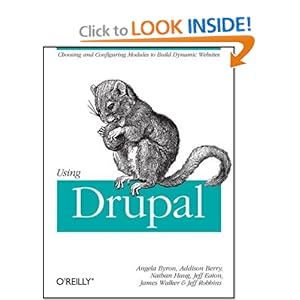I have read a lot of Drupal books as well as online materials. This particular book is one I was looking forward to for a long time. It was just released in December 2008 and is from O’Reilly Press. I have never made it a secret that I find O’Reilly’s books to be consistently good, and usually the best in any category in which they have offerings available. This book lived up to my expectations.
Using Drupal is easily the best book I have read so far for helping a person who knows nothing about the content management system (but who has a base familiarity with web hosting) figure out how the software works, how to add and configure features, and how to make powerful and useful web sites.
The book begins with a very clear, yet detailed introduction to Drupal; what it is, how it works, and the history behind how the project was conceived and the evolution of web site development over the years. It then continues with a long chapter that gives a crash course in each of the unique aspects of the Drupal system: content management, modules, access control, roles and permissions, taxonomy, theming and more are introduced with clear and useful examples.
After this is where the book steps out of the crowd and into a league of its own. Starting with chapter three we are served a series of well written chapters, each describing how to use a specific module or set of modules to do something wonderful with Drupal that is useful, interesting, and powerful. We learn how to use the Content Construction Kit (CCK) module with the Views module to build useful forms for displaying data in a way that is appealing and easily understood by site visitors. We are shown how to create multilingual sites, sites with product reviews, an internal wiki for group collaboration, an online store, and much more. All have clear descriptions of the process, the options available, and great examples.
One of my favorite chapters is number six, which discusses managing workflow. Perhaps you have a busy site with lots of contributors and a few people who are ultimately responsible for posting the created content after it is reviewed. This chapter describes how to make this process much more efficient than I would have done it originally by using actions and triggers with the Workflow module to have newly created content automatically enter an approval queue while notifying the editor responsible about its existence and still allowing the original user access to modify the content while it waits for approval. This allows you to see content in various states, perhaps approve or simply make notes on it, and not waste your reviewer’s time forcing them to check whether content is waiting for review or not by giving them automatic notifications (which may be configured many ways). That is a great idea that I would not have thought of or figured out by myself, and it is just one of the well thought out and elegant designs this book presents.
I still have one more Drupal book en route, and another that I want to buy. If I think they are worth sharing, I’ll post a review of each of them in the coming weeks.

yes, please 😀
I’m pretty fond of O’Reilly books myself and have thought about learning to work with Drupal. Thanks for this review.